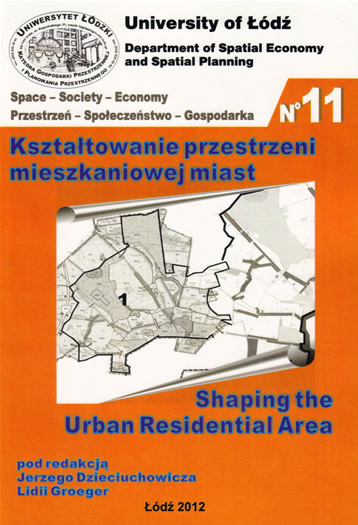PRAKTYKA KSZTAŁTOWANIA ZABUDOWY MIESZKANIOWEJ NA POZIOMIE PLANOWANIA MIEJSCOWEGO
DOI:
https://doi.org/10.18778/1733-3180.11.04Abstrakt
The actual legislation in Poland enables to design space at three-level planning process. Aforementioned levels differ in terms of planning scale and minuteness. First level of shaping spatial policy is determined by creating general rules and directions of land use at the area of entire commune. Ways of spatial development are being established in the strategic document determining conditionings and policy of land use. In the light of polish legislation it is a normative act, which means it cannot be considered as a domestic law, but rather as a framework of further planning decisions. Another level in space shaping leads by defining precise rules of land use in the land development plan. Minuteness of this document is much more advanced and the document itself has a status of domestic act, which means it determines writs, prohibitions and admissions towards particular activities in space. The aim of mentioned activities is to form rules of land use and form of development. Areas, in which none of mentioned documents have not been established, possibility of shaping development and land use can be planned on the basis of administrative decision determining forms of development and land use. But it is not the most fortunate method for space itself, because decisions shape development in an isolated way. Issue of shaping forms of land use and development differs in each mentioned levels. Location of housing space in the urban agglomeration area, occurrence of environmental protection forms in the analysed terrain or terrains endangered of natural processes have significant influence on creating space policy in the scale of administrative unit, commune in particular. The scale of land development plan generates problems in which much more minuteness of urban detail must be considered. The most significant are: mixing dwelling and service function, problem of acoustic and optic protection, problem of shaping homogeneous housing space. The third level of planning act (administrative decision determining forms of development and land use is highly imperfect. It does not make the possibility of creating space composition in plot adjacented to analysed and precludes creation of proper forms of communication and functional system in the entire area. Urbanists in their professional experience have to force many interdisciplinary problems concerning space that cover issues of capacity, cultural environment, natural environment, socio-economical problems. Each one of problem reflects in planning acts and studies, elaborated by local governments.
Pobrania
Bibliografia
Bielecki C., 1996, Gra w miasto, Wydawnictwo Fundacja Dom dostępny, Warszawa.
Google Scholar
Chmielewski J. M., 1996, Teoria urbanistyki. Wybrane zagadnienia, Oficyna Wydawnicza Politechniki Warszawskiej, Warszawa.
Google Scholar
Szmidt B., 1998, Ład przestrzeni, Agencja Wydawnicza Kanon, Warszawa.
Google Scholar
Nowa Karta Ateńska 2003, Wizja miast XXI wieku, Lizbona 2003.
Google Scholar
Plan Ochrony Chojnowskiego Parku Krajobrazowego – Uchwała nr 573/XLIII/2006 Rady Miejskiej w Górze Kalwarii z dnia 25 kwietnia 2006 r.
Google Scholar
Plan Ochrony Parku Wzniesień Łódzkich – Rozporządzenie nr 5/2003 Wojewody Łódzkiego z dn. 31 lipca 2003 r. (Dz. Urz. Woj. Łódzkiego, 2003, nr 231, poz. 2162).
Google Scholar
Prawo ochrony środowiska z dnia 27 kwietnia 2001 r. (Dz. U., 2001, nr 62, poz. 627 z późniejszymi zmianami).
Google Scholar
Rozporządzenie Ministra Infrastruktury w sprawie warunków technicznych, jakim muszą odpowiadać budynki i ich usytuowanie z dnia 12 kwietnia 2002 r. (Dz. U., 2002, nr 75, poz. 690).
Google Scholar
Rozporządzenie Ministra Środowiska w sprawie dopuszczalnych poziomów hałasu w środowisku z dnia 14 czerwca 2007 r. (Dz. U., 2007, nr 120, poz. 826).
Google Scholar
Ustawa prawo budowlane z dnia 7 lipca 1994 r. (Dz. U., 1994, nr 89, poz. 414 z późniejszymi zmianami).
Google Scholar
Ustawa o ochronie gruntów rolnych leśnych z 3 lutego 1995 r. (tekst jedn. Dz. U., 2004, nr 121, poz. 1266 z późniejszymi zmianami).
Google Scholar
Ustawa o gospodarce nieruchomościami z dnia 21 sierpnia 1997 r. (Dz. U., 1997, nr 115, poz. 741 z późniejszymi zmianami).
Google Scholar
Ustawa prawo wodne z dnia 18 lipca 2001 r. (Dz. U., 2001, nr 115, poz. 1229 z późniejszymi zmianami).
Google Scholar
Ustawa o planowaniu i zagospodarowaniu przestrzennym z dnia 27 marca 2003 r. (Dz. U., 2003, nr 80, poz. 717 z późniejszymi zmianami).
Google Scholar
Pobrania
Opublikowane
Jak cytować
Numer
Dział
Licencja

Praca jest udostępniana na licencji Creative Commons Attribution-NonCommercial-NoDerivatives 3.0 Unported License.









